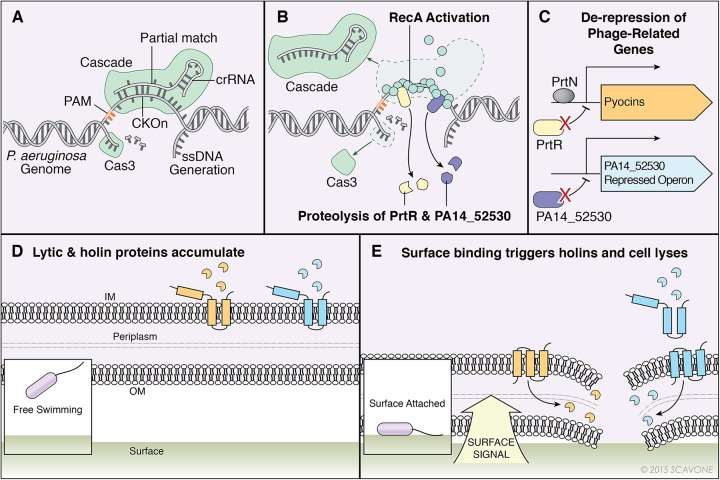FIG 7 .
Model of CRISPR-dependent, biofilm-specific death of Pseudomonas aeruginosa. (A) Cascade (CRISPR-associated complex for antiviral defense) was targeted to the DMS3-42 PS-CKOn using CRISPR2 spacer 1 crRNA. The partial match between CRISPR2 spacer 1 and the PS-CKOn recruits nuclease Cas3, which cleaves the single strand of DNA displaced in the R-loop, but the mismatches at positions +9 and +11 in the crRNA prevent lethal nuclease activity. ssDNA, single-stranded DNA. (B) The single-stranded DNA generated from Cas3 nuclease activity recruits RecA, which polymerizes, forms a helical filament, and is activated. The activated RecA induces proteolysis of pyocin repressor PrtR and transcriptional repressor PA14_52530. (C) The proteolysis of PrtR allows binding of transcriptional activator PrtN, which in turn induces pyocin gene expression, including that of the associated lambda-like lysis cassette. The proteolysis of PA14_52530 allows expression of the PA14_52530-repressed operon, including putative phage-related lysis genes. (D) The highly expressed lambda-like lysis cassette encoded in the pyocin operon in addition to the highly expressed putative phage-related lysis genes in the PA14_52520-repressed operon leads to accumulation lysis proteins in planktonic cells. IM, inner membrane; OM, outer membrane. (E) Bacteria interacting with a surface trigger the activation of lysis proteins, leading to cell lysis and death.

